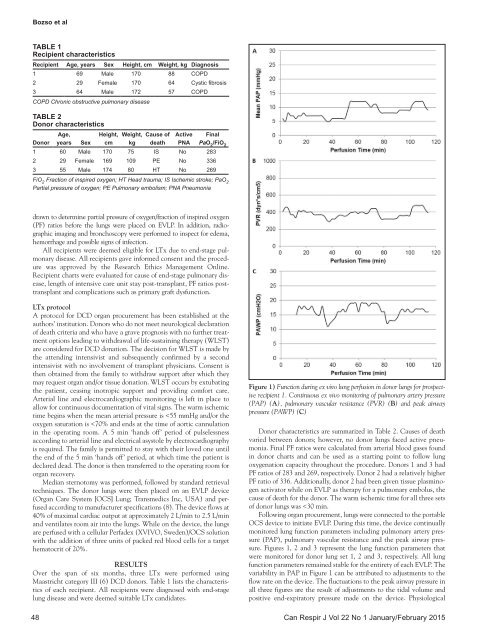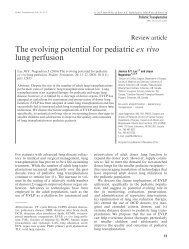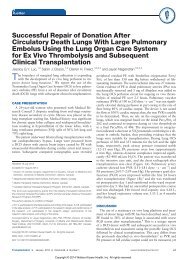Lung transplantation from donors after circulatory death using portable ex vivo lung perfusion.
Sabin Bozso, Vishnu Vasanthan, Jessica G.Y. Luc, Katie Kinaschuk, Darren H Freed, Jayan Nagendran. Background: Donation after circulatory death is a novel method of increasing the number of donor lungs available for transplantation. Using organs from donors after circulatory death has the potential to increase the number of transplants performed. Methods: Three bilateral lung transplants from donors after circulatory death were performed over a six-month period. Following organ retrieval, all sets of lungs were placed on a portable ex vivo lung perfusion device for evaluation and preservation. Results: Lung function remained stable during portable ex vivo perfusion, with improvement in partial pressure of oxygen/fraction of inspired oxygen ratios. Mechanical ventilation was discontinued within 48 h for each recipient and no patient stayed in the intensive care unit longer than eight days. There was no postgraft dysfunction at 72 h in two of the three recipients. Ninety-day mortality for all recipients was 0% and all maintain excellent forced expiratory volume in 1 s and forced vital capacity values post-transplantation. Conclusion: The authors report excellent results with their initial experience using donors after circulatory death after portable ex vivo lung perfusion. It is hoped this will allow for the most efficient use of available donor lungs, leading to more transplants and fewer deaths for potential recipients on wait lists.
Sabin Bozso, Vishnu Vasanthan, Jessica G.Y. Luc, Katie Kinaschuk, Darren H Freed, Jayan Nagendran. Background: Donation after circulatory death is a novel method of increasing the number of donor lungs available for transplantation. Using organs from donors after circulatory death has the potential to increase the number of transplants performed. Methods: Three bilateral lung transplants from donors after circulatory death were performed over a six-month period. Following organ retrieval, all sets of lungs were placed on a portable ex vivo lung perfusion device for evaluation and preservation. Results: Lung function remained stable during portable ex vivo perfusion, with improvement in partial pressure of oxygen/fraction of inspired oxygen ratios. Mechanical ventilation was discontinued within 48 h for each recipient and no patient stayed in the intensive care unit longer than eight days. There was no postgraft dysfunction at 72 h in two of the three recipients. Ninety-day mortality for all recipients was 0% and all maintain excellent forced expiratory volume in 1 s and forced vital capacity values post-transplantation. Conclusion: The authors report excellent results with their initial experience using donors after circulatory death after portable ex vivo lung perfusion. It is hoped this will allow for the most efficient use of available donor lungs, leading to more transplants and fewer deaths for potential recipients on wait lists.
- TAGS
- research
Create successful ePaper yourself
Turn your PDF publications into a flip-book with our unique Google optimized e-Paper software.
ozso et al<br />
Table 1<br />
Recipient characteristics<br />
Recipient age, years S<strong>ex</strong> Height, cm Weight, kg Diagnosis<br />
1 69 Male 170 88 COPD<br />
2 29 Female 170 64 Cystic fibrosis<br />
3 64 Male 172 57 COPD<br />
COPD Chronic obstructive pulmonary disease<br />
Table 2<br />
Donor characteristics<br />
age,<br />
Height, Weight, Cause of active Final<br />
Donor years S<strong>ex</strong> cm kg <strong>death</strong> PNa PaO 2 /FiO 2<br />
1 60 Male 170 75 IS No 283<br />
2 29 Female 169 109 PE No 336<br />
3 55 Male 174 80 HT No 269<br />
FiO 2 Fraction of inspired oxygen; HT Head trauma; IS Ischemic stroke; PaO 2<br />
Partial pressure of oxygen; PE Pulmonary embolism; PNA Pneumonia<br />
drawn to determine partial pressure of oxygen/fraction of inspired oxygen<br />
(PF) ratios before the <strong>lung</strong>s were placed on EVLP. In addition, radiographic<br />
imaging and bronchoscopy were performed to inspect for edema,<br />
hemorrhage and possible signs of infection.<br />
All recipients were deemed eligible for LTx due to end-stage pulmonary<br />
disease. All recipients gave informed consent and the procedure<br />
was approved by the Research Ethics Management Online.<br />
Recipient charts were evaluated for cause of end-stage pulmonary disease,<br />
length of intensive care unit stay post-transplant, PF ratios posttransplant<br />
and complications such as primary graft dysfunction.<br />
LTx protocol<br />
A protocol for DCD organ procurement has been established at the<br />
authors’ institution. Donors who do not meet neurological declaration<br />
of <strong>death</strong> criteria and who have a grave prognosis with no further treatment<br />
options leading to withdrawal of life-sustaining therapy (WLST)<br />
are considered for DCD donation. The decision for WLST is made by<br />
the attending intensivist and subsequently confirmed by a second<br />
intensivist with no involvement of transplant physicians. Consent is<br />
then obtained <strong>from</strong> the family to withdraw support <strong>after</strong> which they<br />
may request organ and/or tissue donation. WLST occurs by <strong>ex</strong>tubating<br />
the patient, ceasing inotropic support and providing comfort care.<br />
Arterial line and electrocardiographic monitoring is left in place to<br />
allow for continuous documentation of vital signs. The warm ischemic<br />
time begins when the mean arterial pressure is





